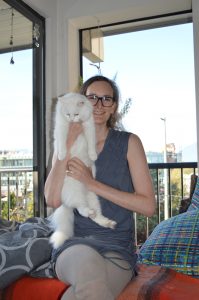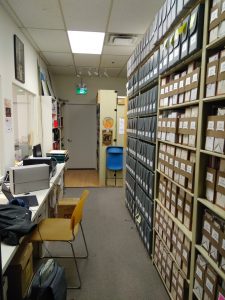Today I had an interview with Brady Marks, which was the first of the five artist interviews for my project. Before I went to her place, I dropped by VIVO to pick up a box of electronic for Brady as she requested. At VIVO, everyone seemed busier than usual preparing for the live performance shows starting tonight. I briefly chatted with Audrey about New Forms Festival; I went to see the shows on Saturday night, and the performance by Juliana Huxtable at Fei & Milton Wong Experimental Theatre (at SFU Woodward) was particularly inspirational to me. The combination of her voice/words and musical instruments such as piano, harp, and drums created the strong harmony of the sounds. Then I checked with Karen my interview questions for Brady. The questions I came up with based on my research were good, Karen said, and she suggested me to add one question that asks the artist about the positioning of media art in art historical context. Karen showed me a 3D animated sculpture that Brady built in collaboration with VIVO, and now it is stored in the equipment room. I was already impressed by the work in the video that I watched during my research on Brady, but it was great to see that in person and before the interview where I was going to ask her more about the work. After that, I headed out to Brady’s place with the box.
The meeting time with Brady was scheduled at 3 pm at her place, but she wasn’t at home when I arrived there. I started worrying and called Brady twice, texted her that I was there because she didn’t pick up her phone. After 15 minutes of waiting, Brady showed up and I learned that she was at a bakery to grab some treats for me. I felt embarrassed and surprised at the same time, realizing how I was so stressed from being off schedule and worried when I couldn’t reach her through a phone. Anyway, Brady was very welcoming and generous. As we got into her room, she gave me a little tour of her room/studio. Being in such a private space of an artist, my eyes were wide open, trying to observe every detail. I knew that she worked mostly in digital media, but in her studio, I saw there were some works in progress in physical form and very low tech such as a cardboard box and some strings. I could see ideas of her art making are generated through playing with accessible materials, and she enjoys making things from a simple idea, for instance, making her own “Stranger Things’ light” which flickers a few times and then certain colour of light turns on according to alphabet/word with her computer programming skills. At her studio, I found many things that resonate what Fortnum said in her article: “The artist may ‘suspend’ their conscious deliberations, creating a sense for then that the medium has its own volition and that the work ‘talks back’ to them.” “Artists enjoy the challenge of potential, and the pleasure of surprising themselves and so create spaces for not knowing, both physical and intellectual.”
Brady is an incredibly generous artist, and she even let me go through her book shelve in the living room while she was making coffee for us.
Before the interview, I explained her about my project and about myself in order to inform her the objective of my project. The interview with her went well. She gave it an insightful talk and I learned a lot by listening to her words carefully describing her artistic practice. What had struck me the most was when she talked about how artists’ experimentation of technology as a medium without constraints of commercial businesses allows us to develop the meaning of the medium before companies such as MTV, Disney or Sony show them to mass audiences. That reminds me of our class discussion when we talk about how artists are feeding the commercial world. I think my understanding of artists’ role in society has been expanded by interviewing with Brady.
As an interviewer, I learned that the structure of the interview could be looser. For this interview, I structured the questions that I wanted to ask her in my way of thinking, but I realized in the conversation with Brady that I should be more flexible and responsive to what has been said during the interview. In addition to that, I think I should narrow the interview question down to more specific ones because some of my questions were already answered when she was answering another question. I will try these lessons for next interview session and would like to see how it goes. This time I was helped a lot by Brady with her friendly personality and her generosity. After the interview, I stayed at her place for a while, having some pastry and talking about cool artworks with Brady and her cat. She showed me a book of Jim Campbell and a video called “The Clock” by Christian Marclay. Overall, it was such a great time and a good start for my project (:
Brady Marks is a Vancouver-based digital media artist and DJ. Marks’ works explore in sound, light, and video.

Photo of Brady with her lovely cat.
*Artists info from the web:
Juliana Huxtable is an American artist, DJ, and model who works in photography, video, performance, poetry, and music. After gaining visibility in the New York club scene, Huxtable came to prominence in the art world with her inclusion in the 2015 New Museum Triennial, Surround Audience. In her work, Huxtable uses her own body as a primary subject to archive and abstract representations of art history, the Internet, and the intersection of identity and technology. She draws from a broad range of references, including the Nuwaubian movement. Huxtable is a co-founder of the nightclub Shock Value and is a member of the New York City-based collective House of Ladosha. She currently lives and works in New York City.
Jim Campbell is a contemporary San Francisco based artist who is known for his LED light works. Campbell began his artistic career in filmmaking but switched to electronic sculpture in 1990 and started making his iconic LED matrix works in 2000. His current work combines film, sound, and LED light installations.
Christian Ernest Marclayis an American/Swiss visual artist and composer. Marclay’s work explores connections between sound, noise, photography, video, and film. A pioneer of using gramophone records and turntables as musical instruments to create sound collages, Marclay is, in the words of critic Thom Jurek, perhaps the “unwitting inventor of turntablism.” His own use of turntables and records, beginning in the late 1970s, was developed independently of but roughly parallel to hip hop’s use of the instrument.



